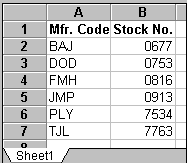
Description A specified value is compared against values in a range. The position of the matching value in the search range is returned.
Syntax MATCH ( lookup_value, lookup_range, comparison )
| Argument | Description |
|---|---|
| lookup_value | The value against which to compare. It can be a number, text, or logical value or a reference to a cell that contains one of those values. |
| lookup_range | The range to search and contains only one row or one column. The range can contain numbers, text, or logical values. |
| comparison | A number that represents the type of comparison to be made between lookup_value and the values in lookup_range. When you omit this argument, comparison method 1 is assumed.When comparison is 1, the largest value that is less than or equal to lookup_value is matched. When using this comparison method, the values in lookup_range must be in ascending order (for example, ...-2, -1, 0, 1, 2..., A through Z, False, True).When comparison is 0, the first value that is equal to lookup_value is matched. When using this comparison method, the values in lookup_range can be in any order.When comparison is -1, the smallest value that is greater than or equal to lookup_value is matched. When using this comparison method, the values in lookup_range must be in descending order (for example, True, False, Z through A, ...2, 1, 0, -1, -2...). |
Remarks When using comparison method 0 and lookup_value is text, lookup_value can contain wildcard characters. The wildcard characters are * (asterisk), which matches any sequence of characters, and ? (question mark), which matches any single character.
When no match is found for lookup_value, #N/A is returned.
Examples The following examples use this worksheet.

This function returns 5:
This function returns 2:
See Also HLOOKUP, INDEX (non-array type), LOOKUP, VLOOKUP
